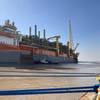Seaborne Reefer Trade Continues to Expand: Drewry
Despite moderating perishable seaborne trade growth, continued modal shift will sustain expansion in the containerised reefer trade and so support freight rate development, according to Drewry’s latest Reefer Shipping Annual Review and Forecast 2018/19 report, by global shipping consultancy Drewry.
Global seaborne reefer trade continues to expand, posting a gain of over 5% in 2017 to 124 million tonnes, a big improvement on trend growth over the past 10 years of 3.6% a year. Underpinning this progress was strong growth in banana, meat and fish trades.
Drewry estimates that containerised reefer traffic expanded by 8% in 2017, outpacing the growth in overall seaborne reefer trade. Driving this acceleration has been the continued shift of cargo from the declining specialised reefer fleet to the container mode.
“This modal shift in favour of container shipping lines is expected to continue as the specialised fleet shrinks further,” said Drewry’s director of research products Martin Dixon. “Indeed the specialised sector’s share of total seaborne reefer trade is forecast to fall from 20% today to just 14% for 2022, with container lines picking up the slack.”
However, container equipment availability remains an issue, particularly in hinterland locations where carriers have been reluctant to reposition empty reefer boxes. Production of new refrigerated container equipment recovered in 2017 and the fleet is forecast to continue growing ahead of cargo demand, but despite this tight supply conditions are expected to remain.
“Buoyant trade development and tight availability of container equipment in certain regions have enabled some strengthening in reefer container freight rates relative to dry freight pricing,” continued Dixon. “These dynamics are expected to further support reefer container freight pricing over the next few years.”
Drewry estimates that average containerised reefer freight rates rose 3% in the six quarters to 2Q18, while average dry freight box rates fell 14% (see chart above). This demonstrates that despite broader weakness in the container shipping market, reefer rates have held up, rewarding those carriers that have chosen to invest in the cargo segment. Meanwhile, time charter rates for specialist reefer vessels recovered in 2017 from the previous year’s lows but have since come under pressure and are expected to remain so.
However, Drewry forecasts that the growth in seaborne perishable reefer trade will moderate slightly over the next five years to nearer 3% a year. This is due in part to an anticipated correction in banana and exotic fruit trades in 2018 following inclement weather conditions in the final months of 2017, as well as a looming trade war between US and China that will affect the reefer dominant westbound transpacific trade in particular.












